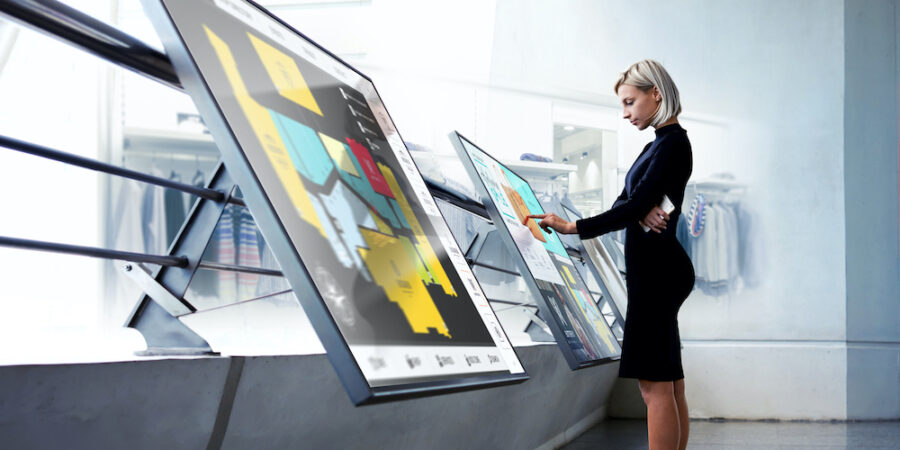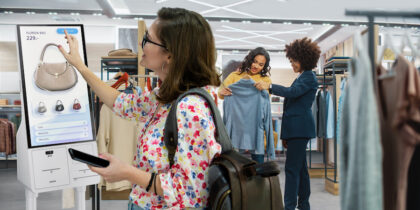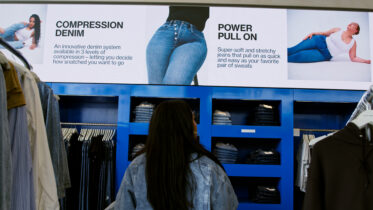A handful of New York City taxis are causing busy travelers to think twice before ridesharing to catch their flight. Instead of “Vacant” signs, these cabs are using small digital displays to show the estimated travel time to both JFK and Newark airports. Part of a Delta Airlines campaign, this simple heads-up may be convincing some travelers to skip the ride-share and hop in a cab instead.
This example points to a larger transportation trend: integrating technology to influence passenger behavior and enhance the overall experience. Although many of these innovations are designed specifically for use in airports, bus terminals and subway stations, the principles behind them could be applied to any industry.
For instance, what if an LED sign in front of your fitting rooms told shoppers their exact wait time for an available dressing room? Or how long before they could be seen by a sales associate? You’d probably be much more willing to stick around for an oil change at an auto shop if you could confirm beforehand that you could make that 1:30 lunch.
Here are a few more insights retailers can learn from transportation and how travel and retail can both benefit from displays:
Keep people in the know
We’re in an age of impatience; nowhere is that more apparent than in transportation. Modern travelers want instant access to up-to-the-minute arrival and departure times, delays, terminal changes, baggage pickup and so on. Being able to look up and see a real-time update showing when the plane will be there helps people overcome the anxiety they feel when they don’t know what’s going on.
How to plan and deploy direct view LED signage
Everything you need to know about choosing your LED displays for optimal viewing indoors and out. Download Now
For most people, shopping is considerably less tense than traveling. Still, digital signage can make relevant information readily available to shoppers, yielding powerful results. Nielson found that four out of five product brands experienced significant increases of up to 33 percent additional sales through the use of digital out-of-home media. Other studies corroborate these findings, showing that retail digital signage has caused people to change their minds on what they came in to buy.
Be a thoughtful guide
Beyond information, some transportation leaders are taking a more proactive approach to helping travelers (literally) navigate. For instance, New York’s Metropolitan Transit Authority (MTA) recently added next-stop signs to certain buses. This way, travelers are aware of transfer options on their route — as well as anticipated arrival times.
The same challenge in transport is happening in big box stores like Ikea, Walmart and Costco. When people enter a store or a shopping mall and see some digital directional signage or self-service kiosks, they can get to where they want to go quickly and easily.
With display technology, shoppers can even get customized directions from their current location to their desired destination. This can free up retail staff and create a more positive, convenient shopping experience for customers.
Add entertainment value
Travel is often fraught with anxiety. As such, forward-thinking transportation players are always looking for new ways to entertain travelers. At the Charlotte-Douglas International Airport, for instance, there’s a 2,000-square-foot LED display that runs along Terminal A. The concourse display features “Interconnected,” a stunning visualization that displays a mesmerizing kaleidoscope of colors, shapes and textures, all dynamically driven by real-time airport data such as flight status and traffic.
The direct view LED display helps to calm people’s nerves and make travel less stressful.
Retail can do the same thing. Duty Free Americas, a tax-free retailer located at airports and borders, has LED video walls and digital signage on the exterior and interior of their stores to engage passersby and create a relaxing environment as people wait for their flights.
Some people don’t like to be around a ton of people in a shopping center, so using direct view LED displays can help people become more relaxed in a shopping environment, whether that’s showing art or pictures or videos of oceans or a forest. Whatever makes the shopping environment more peaceful.
Always be innovating
Making travel faster, easier and more efficient is a never-ending process. Fortunately, new technology — sought by forward-thinking transportation hubs — can greatly speed the process. Take Hartsfield-Jackson Atlanta International Airport, home to the world’s first fully biometric terminal. The terminal uses facial recognition technology to save international travelers from having to show their passports every time they pass through. Travelers love it: According to one study, nearly three-quarters of travelers (72 percent) prefer the new method to standard boarding.
Some forward-thinking retailers, including Amazon Go, are already exploring the possibilities of facial recognition technology. The technology can recognize, for example, older male shoppers and younger female shoppers, then dynamically change signage to drive them to a section that they’d be most interested in.
With its time sensitivities and extreme focus on logistics, transportation is a natural industry to lead the way for integrating technology into the user experience. But the principles here are industry-agnostic. It’s about people, and the behaviors and expectations they have in our modern, impatient, on-demand world.
Brighten your storefront and inform shoppers with today’s most comprehensive direct view LED portfolio on the market. And find everything you need to know about choosing your LED displays for optimal viewing, indoors and out, in this free white paper.








